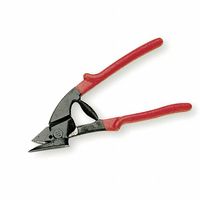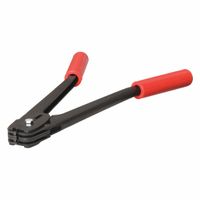Call +(254) 703 030 000 / 751 483 999 / 721 704 777
- Home
- Packaging Shipping
- Strapping
- Strapping Tools
- Tools For Steel Strapping
.....Read More
Frequently Asked Questions
What are the best tools for steel strapping?
The best tools for steel strapping include:
1. **Manual Tensioners**: These are essential for applying tension to the steel strap around the package. They are suitable for low-volume applications and are cost-effective. Popular models include the Signode ST and the MIP-1300.
2. **Sealers**: Used to crimp the seal and secure the strap. They come in single or double notch varieties. The Signode C-3124 and the MIP-1200 are well-regarded options.
3. **Combination Tools**: These integrate tensioning, sealing, and cutting into one device, increasing efficiency. The Signode SCM and the Fromm A333 are popular choices for their durability and ease of use.
4. **Pneumatic Tools**: Ideal for high-volume operations, these tools use air pressure to tension and seal the strap, reducing manual effort. The Signode PN2-114 and the Fromm A480 are commonly used in industrial settings.
5. **Battery-Powered Tools**: Offering mobility and ease of use, these tools are suitable for medium to high-volume applications. The Signode BXT3 and the Fromm P331 are known for their reliability and performance.
6. **Dispensers**: Essential for holding and dispensing the steel strap efficiently, preventing tangles and ensuring smooth operation. The Signode DF-15 and the Vestil STRAP-D are popular models.
7. **Cutters**: Designed to safely and cleanly cut steel strapping, minimizing the risk of injury. The MIP-8100 and the Signode CU-25 are widely used for their precision and safety features.
These tools are selected based on factors like volume, budget, and specific application needs, ensuring efficient and secure strapping operations.
How do you use a steel strapping tensioner?
To use a steel strapping tensioner, follow these steps:
1. **Prepare the Strapping**: Cut the steel strapping to the desired length using a strapping cutter. Ensure the strapping is free of any kinks or twists.
2. **Position the Strapping**: Wrap the strapping around the package or load. Overlap the ends of the strapping by a few inches on top of the load.
3. **Load the Tensioner**: Place the tensioner on top of the overlapped strapping. The open slot of the tensioner should face the user. Insert the bottom strap into the tensioner’s base, ensuring it is aligned properly.
4. **Insert the Top Strap**: Feed the top strap through the cutter assembly and the gripper foot of the tensioner. Pull the strap tight manually to remove any slack.
5. **Tension the Strap**: Turn the tensioner handle clockwise to tighten the strap. Continue turning until the desired tension is achieved. Be cautious not to over-tighten, as this can damage the strapping or the load.
6. **Seal the Strap**: Once tensioned, place a metal seal over the overlapped strapping. Use a sealer tool to crimp the seal, securing the strapping in place.
7. **Cut the Excess Strap**: Use the tensioner’s built-in cutter or a separate cutting tool to trim the excess strapping. Ensure the cut is clean to prevent sharp edges.
8. **Remove the Tensioner**: Release the tensioner by lifting the handle, allowing the gripper foot to disengage. Carefully remove the tensioner from the strapping.
9. **Inspect the Seal**: Check the seal to ensure it is properly crimped and secure. Adjust if necessary.
10. **Safety Check**: Ensure all tools are safely stored and the work area is clear of any strapping debris.
What is the difference between a sealer and a tensioner in steel strapping?
A sealer and a tensioner are both essential tools used in the process of steel strapping, but they serve different functions.
A tensioner is used to apply tension to the steel strap around the package or load. It ensures that the strap is tight and secure, preventing the load from shifting during transport. The tensioner works by gripping the strap and pulling it tight, allowing the user to adjust the tension to the desired level. There are manual, pneumatic, and battery-powered tensioners, each offering varying levels of efficiency and ease of use.
On the other hand, a sealer is used to secure the tensioned strap by creating a seal. Once the strap is properly tensioned, the sealer is applied to crimp a metal seal around the overlapping ends of the strap. This crimping action locks the strap in place, maintaining the tension and ensuring the load remains secure. Sealers can be manual or pneumatic, and they are designed to work with specific types of seals, such as open or closed seals.
In summary, the tensioner is responsible for tightening the strap, while the sealer is responsible for locking the strap in place. Both tools are crucial for effective steel strapping, ensuring that loads are safely and securely bound for storage or transportation.
How do you maintain steel strapping tools?
To maintain steel strapping tools effectively, follow these steps:
1. **Regular Cleaning**: After each use, clean the tools to remove any dust, dirt, or debris. Use a soft cloth or brush to wipe down the surfaces. For stubborn grime, use a mild detergent solution and ensure the tools are thoroughly dried afterward to prevent rust.
2. **Lubrication**: Regularly lubricate moving parts with a light machine oil to ensure smooth operation. Focus on joints, hinges, and any other moving components. Avoid over-lubrication, which can attract dirt.
3. **Inspection**: Conduct routine inspections for wear and tear. Check for any signs of damage, such as cracks, bends, or worn-out parts. Pay special attention to cutting edges and tensioning mechanisms.
4. **Sharpening**: If the tool includes cutting components, ensure they are sharp. Dull blades can lead to inefficient operation and increased wear. Use appropriate sharpening tools or replace blades as necessary.
5. **Tension Calibration**: Regularly check and calibrate the tension settings to ensure they are accurate. Incorrect tension can lead to ineffective strapping and potential tool damage.
6. **Storage**: Store tools in a dry, clean environment to prevent rust and corrosion. Use protective cases or covers if available. Avoid leaving tools in damp or humid areas.
7. **Replacement of Parts**: Replace any worn or damaged parts promptly. Using tools with compromised components can lead to further damage and unsafe operation.
8. **Training**: Ensure all users are properly trained in the correct use and maintenance of the tools to prevent misuse and extend their lifespan.
9. **Professional Servicing**: Periodically have the tools serviced by a professional to ensure they remain in optimal working condition.
By following these maintenance practices, you can extend the life of your steel strapping tools and ensure they function efficiently and safely.
What are the advantages of using combination tools for steel strapping?
Combination tools for steel strapping offer several advantages:
1. **Efficiency**: These tools integrate tensioning, sealing, and cutting into one device, streamlining the strapping process and reducing the time required for each operation.
2. **Cost-Effective**: By eliminating the need for separate tools for each function, combination tools reduce equipment costs and maintenance expenses.
3. **Ease of Use**: With a single tool handling multiple tasks, operators face less complexity, leading to quicker training and improved productivity.
4. **Portability**: Combination tools are typically more compact and lighter than using multiple separate tools, making them easier to transport and use in various locations.
5. **Consistency**: Integrated operations ensure uniform tensioning and sealing, enhancing the reliability and security of the strapping.
6. **Space-Saving**: Using one tool instead of several saves workspace, which is beneficial in crowded or limited environments.
7. **Reduced Operator Fatigue**: Handling one tool instead of multiple reduces physical strain on operators, improving comfort and reducing the risk of repetitive strain injuries.
8. **Versatility**: Many combination tools are adjustable for different strap sizes and materials, offering flexibility for various applications.
9. **Improved Safety**: Fewer tools mean fewer chances for accidents or misuse, enhancing workplace safety.
10. **Enhanced Productivity**: The streamlined process and reduced tool handling lead to faster operations, increasing overall throughput.
These advantages make combination tools a preferred choice for many industries requiring efficient and reliable steel strapping solutions.
How do you choose the right size of steel strapping?
To choose the right size of steel strapping, consider the following factors:
1. **Load Weight and Type**: Determine the weight and nature of the load. Heavier loads require wider and thicker strapping for adequate support. For example, loads over 1,500 pounds typically need strapping that is at least 3/4 inch wide.
2. **Load Stability**: Assess the stability of the load. Unstable or irregularly shaped loads may need wider strapping to ensure they remain secure during transit.
3. **Tension Requirements**: Consider the tension needed to secure the load. Higher tension requires thicker strapping to prevent breakage.
4. **Environmental Conditions**: Evaluate the conditions the strapping will face, such as temperature fluctuations, humidity, or exposure to chemicals. Certain environments may necessitate specific coatings or types of steel strapping.
5. **Handling and Transportation**: Consider how the load will be handled and transported. Loads that will be moved frequently or over long distances may require more robust strapping.
6. **Regulatory Standards**: Check any industry-specific regulations or standards that dictate strapping requirements for safety and compliance.
7. **Strapping Tools and Equipment**: Ensure compatibility with the tools and equipment used for applying the strapping. Some tools may only accommodate specific sizes or types of strapping.
8. **Cost Considerations**: Balance the cost with the performance needs. While wider and thicker strapping offers more security, it also costs more.
9. **Supplier Recommendations**: Consult with suppliers or manufacturers for recommendations based on your specific application needs.
By evaluating these factors, you can select the appropriate size of steel strapping to ensure the safety and security of your load.
What safety precautions should be taken when using steel strapping tools?
When using steel strapping tools, several safety precautions are essential to prevent injuries and ensure safe operation:
1. **Personal Protective Equipment (PPE):** Always wear appropriate PPE, including safety glasses or goggles to protect eyes from flying metal fragments, cut-resistant gloves to prevent hand injuries, and steel-toed boots to protect feet from heavy objects.
2. **Training:** Ensure that all operators are adequately trained in the use of steel strapping tools and understand the potential hazards associated with their use.
3. **Tool Inspection:** Regularly inspect tools for any signs of wear, damage, or malfunction. Do not use tools that are damaged or defective.
4. **Work Area:** Keep the work area clean and free of obstructions. Ensure there is adequate lighting and that the floor is dry to prevent slips and falls.
5. **Proper Handling:** Handle steel strapping with care to avoid cuts. Use appropriate tools to cut and tension the strapping, and never use your hands.
6. **Tensioning:** Do not over-tension the strapping, as this can cause it to snap and create a hazard. Follow manufacturer guidelines for proper tensioning.
7. **Cutting Strapping:** When cutting strapping, stand to the side and use the correct cutting tool. Be aware of the recoil action when the tension is released.
8. **Securing Loads:** Ensure that loads are properly secured and balanced before applying strapping. Do not attempt to strap unstable or unbalanced loads.
9. **Disposal:** Dispose of used strapping properly to prevent tripping hazards and injuries from sharp edges.
10. **Emergency Procedures:** Be familiar with emergency procedures in case of an accident, including first aid measures and how to contact emergency services.
By adhering to these safety precautions, the risk of accidents and injuries when using steel strapping tools can be significantly reduced.



